
Birger Jarl or Birger Magnusson was a Swedish statesman, Jarl of Sweden and a member of the House of Bjelbo, who played a pivotal role in the consolidation of Sweden. Birger also led the Second Swedish Crusade, which established Swedish rule in Finland. Additionally, he is traditionally attributed to have founded the Swedish capital, Stockholm, around 1250. Birger used the Latin title of Dux Sweorum which in English equals Duke of Sweden, and the design of his coronet combined those used by continental European and English dukes.
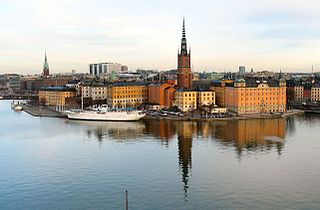
Riddarholmen is a small islet in central Stockholm, Sweden. The island forms part of Gamla Stan, the old town, and houses a number of private palaces dating back to the 17th century. The main landmark is the church Riddarholmskyrkan, used as Sweden's royal burial church from the 17th century to 1950, and where a number of earlier Swedish monarchs also lie buried.
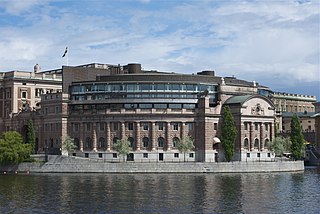
Helgeandsholmen is a small island in central Stockholm, Sweden. It is located north of Stadsholmen, and east of Strömsborg, with which, together with Riddarholmen, it forms Gamla stan, the old town of Stockholm. Helgeandsholmen contains the Riksdag Building and the Museum of Medieval Stockholm, and is connected to neighbouring islands through three bridges: Riksbron, Stallbron, and Norrbro.

Stockholm City Hall is the seat of Stockholm Municipality in Stockholm, Sweden. It stands on the eastern tip of Kungsholmen island, next to Riddarfjärden's northern shore and facing the islands of Riddarholmen and Södermalm. It houses offices and conference rooms as well as ceremonial halls. It is the venue of the Nobel Prize banquet and is one of Stockholm's major tourist attractions.

The Bonde Palace is a palace in Gamla stan, the old town in central Stockholm, Sweden. Located between the House of Knights (Riddarhuset) and the Chancellery House (Kanslihuset), it is, arguably, the most prominent monument of the era of the Swedish Empire (1611–1718), originally design by Nicodemus Tessin the Elder and Jean De la Vallée in 1662-1667 as the private residence of the Lord High Treasurer Gustaf Bonde (1620–1667) it still bears his name, while it accommodated the Stockholm Court House from the 18th century and since 1949 houses the Swedish Supreme Court. On the south side of the building is the street Myntgatan and the square Riddarhustorget, while the alleys Riddarhusgränd and Rådhusgränd are passing on its western and eastern sides.

Birger Jarls torg is a public square on Riddarholmen in Gamla stan, the old town in Stockholm, Sweden.

Wrangel Palace is a townhouse mansion on Riddarholmen islet in Gamla Stan, the old town of Stockholm, in Sweden.
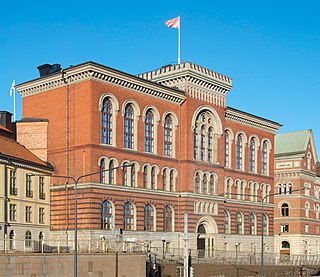
Gamla Riksarkivet is a building at Arkivgatan 3 on Riddarholmen in Stockholm, Sweden. Riksarkivet, the Swedish National Archives, were located in the building until 1968.

Västerlånggatan is a street in Gamla stan, the old town of Stockholm, Sweden. Stretching southward between the squares Mynttorget and Järntorget, it follows the course of the city's now demolished 13th-century defensive wall.

The Admiralty House is an Admiralty House on the islet Skeppsholmen in central Stockholm, Sweden.

The Hotel Skeppsholmen is a hotel on the islet of Skeppsholmen in central Stockholm, Sweden. The hotel comprises two early buildings, individually known as Västra/Östra boställshuset, located along the Långa raden.
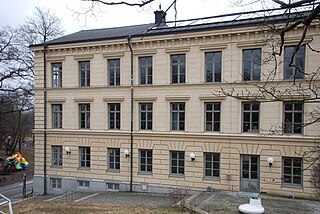
The Nautical Chart Department is a building located on the islet Skeppsholmen in central Stockholm, Sweden.
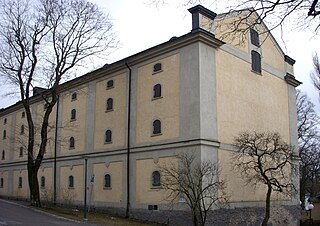
Intendenturförrådet is a building on the islet Skeppsholmen in central Stockholm, Sweden.
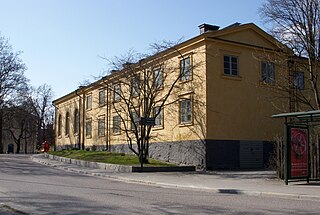
Prästgården is a building on the islet Skeppsholmen in central Stockholm, Sweden.
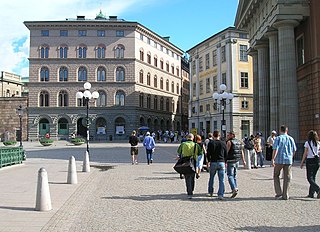
Mynttorget is a public square in Gamla stan, the old town in central Stockholm, Sweden.
Riddarhustorget is a public square in Gamla stan, the old town in central Stockholm, Sweden, named after its location in front of the House of Knights (Riddarhuset).

Vädersolstavlan is an oil-on-panel painting depicting a halo display, an atmospheric optical phenomenon, observed over Stockholm on 20 April 1535. It is named after the sun dogs appearing on the upper right part of the painting. While chiefly noted for being the oldest depiction of Stockholm in colour, it is arguably also the oldest Swedish landscape painting and the oldest depiction of sun dogs.
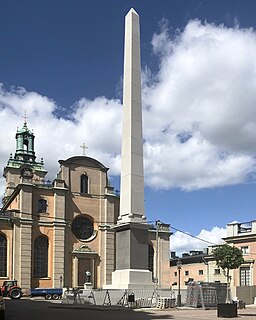
The Obelisk at Slottsbacken is an obelisk monument adjacent to the Royal Palace on Slottsbacken in Old Town, Stockholm, Sweden and is considered to be the very centre point of the Swedish capital city. Unveiled in 1800, it commemorates the deeds of Stockholm's citizenry during the Russo-Swedish War. In 2017, the original obelisk was dismantled due to age- and weather-related damage and was rebuilt, using newly quarried stone, in spring 2020.
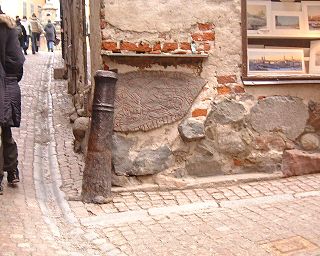
The prehistory of Stockholm is the continuous development and series of events that made the mouth of Lake Mälaren strategically important; a location which by the mid 13th century had become the centre of the newly consolidated Swedish kingdom. The origin of Stockholm pre-dates its written history, and several mythological stories and modern myths have attempted to explain both its emergence and its name.

The architecture of Stockholm has a history that dates back to the 13th century, possibly even earlier. According to some sources, there might have been a simple defense structure, perhaps a small castle, on the northeast part of the island Stadsholmen. Buildings in Stockholm are characterized by their unique location between Lake Mälaren and the Baltic Sea. The Hanseatic League during the great period of industrialization saw a strong desire to modernize the city.






















